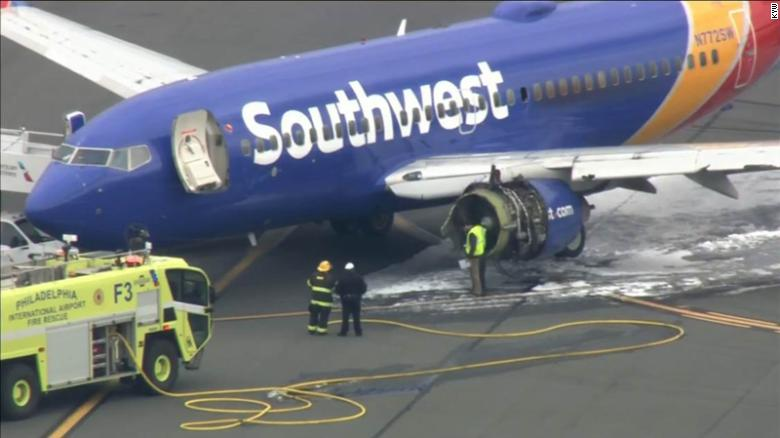On April 17, 2018, at about 11:03 eastern daylight time, a Southwest Airlines (SWA) flight experienced an engine failure while climbing through FL320 en route to the flight’s assigned cruise altitude. Debris from the uncontained engine failure smashed a passenger window. Following the engine failure, the depressurization pushed a passenger partially out of the window, causing critical injuries that led to her death.
Flight Details
The Boeing 737-700 with registration N772SW was performing flight WN1380 from New York La Guardia Airport, New York to Dallas Love Field Airport, Texas with 149 people on board including 144 passengers and 5 crew members. The cockpit crew consisted of Tammie Jo Shults (56-year-old), who had a total of 11,715 flight hours, including 10,513 hours on the Boeing 737, and First Officer Darren Lee Ellisor (44-year-old), who had 9,508 flight hours, with 6,927 hours on the Boeing 737. Captain Shults is a former United States Navy fighter pilot whereas the F/O is a former United States Air Force pilot with experience in the Boeing E-3 Sentry and a veteran in the Iraq War.
Flight 1380 departed from La Guardia Airport (LGA), about 30 minutes earlier with the F/O flying and the captain monitoring. However, when it was climbing through FL320 out of New York, the left-hand engine (CFM56) sustained damage causing the inlet and parts of the cowl to separate from the airframe. They heard a loud sound and felt severe vibration and the aircraft suddenly rolled uncontrollably to the left with a 41-degree bank angle. The pilot immediately took control of the flight and levelled the wings. The cabin altitude alarm sounded immediately. The crew noticed that the rpm of the left engine had dropped to zero and the fuel pressure had also dropped to zero. The crew donned their oxygen masks following the resulting depressurization. Shortly after, the crew reported that they had an engine failure and were to initiate an emergency descent.
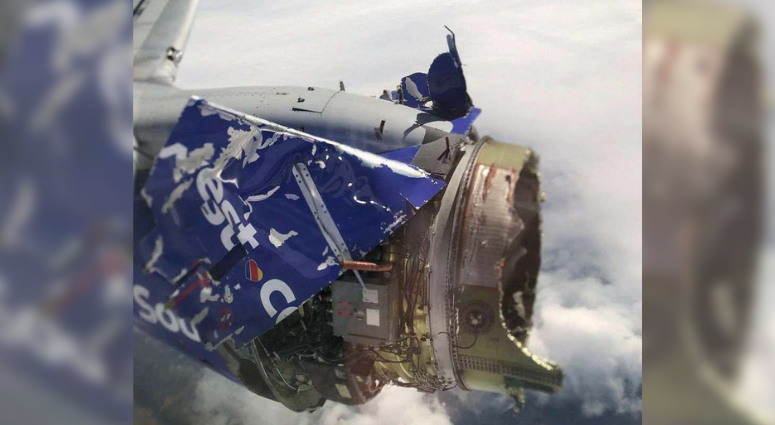
Following the engine failure, the crew shut the affected engine down, conducted an emergency descent and diverted to Philadelphia International Airport, Philadelphia, Pennsylvania. Debris from the damaged engine impacted the side of the fuselage shattering a passenger window and causing the loss of cabin pressure. Parts of the left engine inlet and fan cowl separated from the airframe, and fragments from the inlet and fan cowl struck the left wing, the left-side fuselage, and the left horizontal stabilizer. One of the fan cowl fragments struck the left-side fuselage near a cabin window, and the window departed the aircraft, which resulted in a rapid depressurization.
The flight crew reported that the aircraft was very difficult to control throughout the remainder of the flight due to the extensive damage. Following the engine failure, the captain took over flying the plane and the first officer carried out the emergency checklist. The ATC cleared SW1380 to fly to Philadelphia and asked the crew to maintain an altitude of 11,000 feet. The captain asked to keep the emergency vehicles on standby alongside medical services to meet the aircraft. The crew requested a 20nm final approach, highlighting that they need a longer runway to slow down. Flight 1380 was cleared to land on runway 27L, which is the longest runway at Philadelphia International.
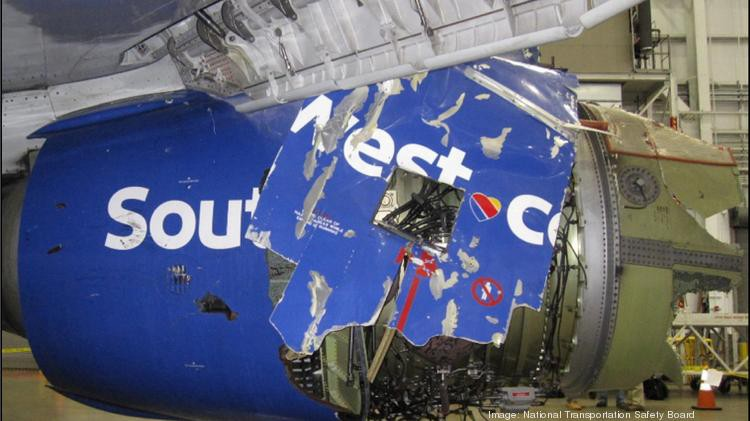
Passenger Injuries
Flight Attendants were telling passengers that they should breathe normally through their masks and that they were receiving oxygen even if the oxygen bag did not inflate. When the flight attendant reached row 14, she saw that the head, upper torso, and arms of the passenger seated in 14A had been pulled outside the aircraft through the window. The flight attendants with the help of two other male passengers pulled the passenger inside and laid the injured passenger across seat 14ABC.
At this point, the F/O said that he was going to check with the flight attendant to see if something happened. The F/O found a flight attendant on the walkie-talkie and heard, “One of the cabin windows was open and someone was sucked out of the window.”
First Officer: Was everyone in their seats and seat belts fastened when we descended?
Flight Attendant: Yes, everyone is still in their seats. Someone helped her pull her back to her seat. I don’t know how she’s doing.
First Officer: Okay, we’re going to slow down.
The captain informed the air traffic controllers that they needed medical support during the landing and asked to get the ambulance to wait for them on the runway, as they had injuries inside the cabin. The crew were cleared for a visual approach on 27L and the tower informed that the emergency services were ready.
Philadelphia Tower: Southwest 1380 Turn right off the runway or park directly on the runway if you wish. The emergency services you need are ready.
Captain: Thank you. We are going to stop by the fire truck. Thank you for your help.
Captain: Thank God, Thank God, Thank God!
The aircraft landed safely on runway 27L, vacated the runway and stopped on the adjacent taxiway. The captain initially flew slower than the recommended speed for emergency descent to reduce the severity of the airframe vibration. The captain also stated she flew the final segment of the approach at a higher-than-normal airspeed of 180 knots because she was concerned about controllability problems and did not want to get too slow.
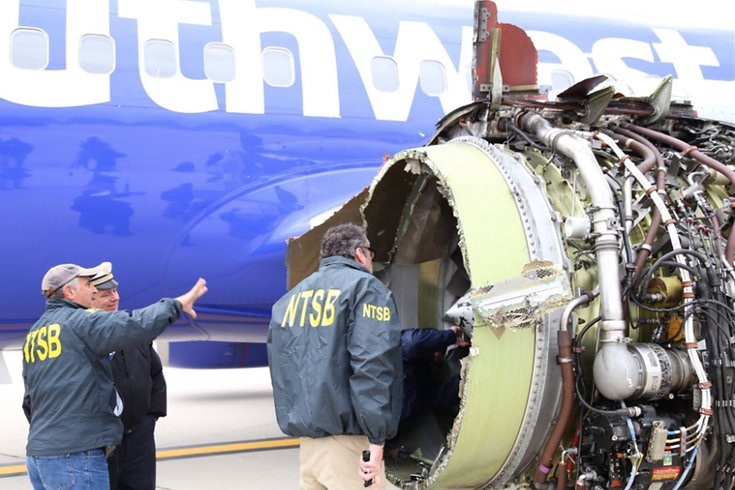
Emergency services foamed the left-hand engine, and the passengers disembarked via stairs onto the taxiway. One of the passengers was taken to a hospital with serious injuries and eight other passengers received minor injuries. The NTSB later reported that the one passenger taken to the hospital has died. She was nearly sucked out of the aircraft and was pulled back into the cabin by fellow passengers.
Southwest Airlines stated that they are deeply saddened to confirm there is one fatality resulting from this accident, the entire Southwest Family is devastated. “This is a sad day and our hearts go out to the family and the loved ones of the deceased customer”, the chairman said. This has been the first inflight fatality ever on a Southwest Airlines aircraft.
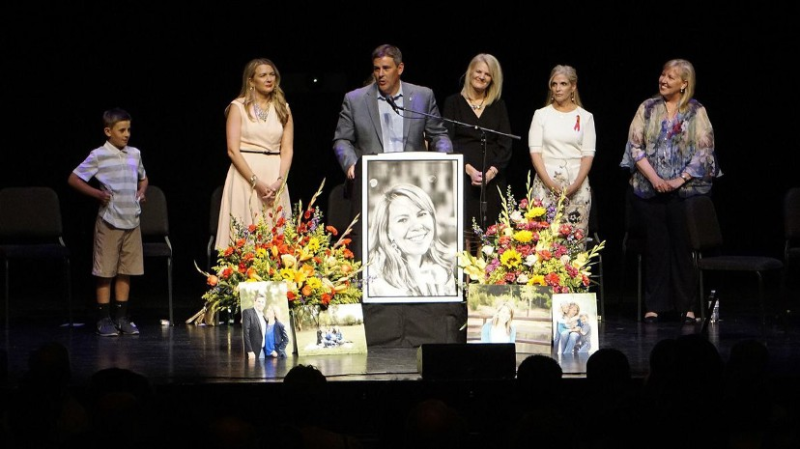
Investigation and Findings
The National Transportation Safety Board (NTSB) launched an investigation into the accident and was assisted by the Federal Aviation Administration (FAA), Boeing, Southwest Airlines and GE Aviation. The investigation found that the left engine failure occurred when one of the fan blades (number-13 fan blade) fractured at its root (referred to as a fan-blade-out [FBO] event). The CFM International CFM56-7B24 turbofan engine has 24 fan blades installed in the fan disk.
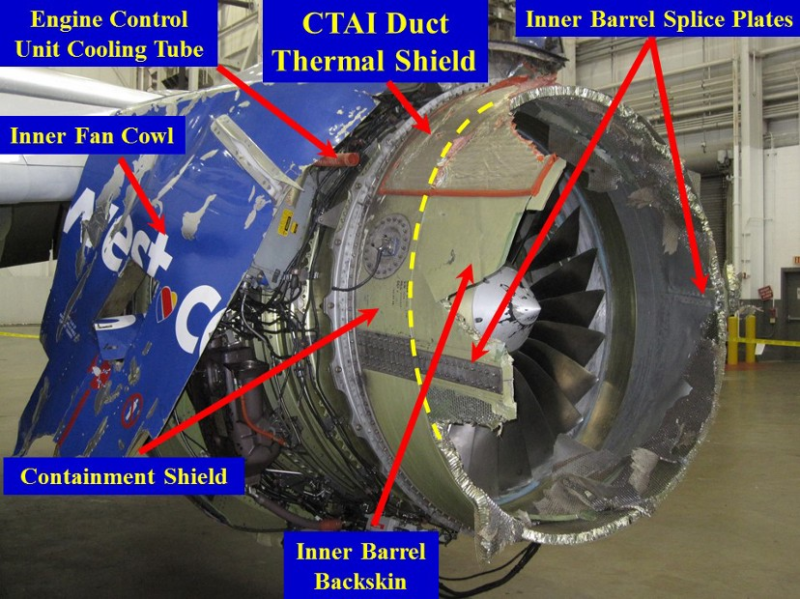
The fan blade had fractured due to a low-cycle fatigue crack that initiated in the dovetail (part of the blade root), which remained within a slot of the fan disk. The separated fan blade impacted the engine fan case and fractured into multiple fragments. Some of those fragments travelled forward of the engine and into the inlet.
In addition, the fan blade’s impact on the fan case caused the fan case to deform locally, travelling both around and forward/aft over a short period of time. This deformation generated large loads that resulted in local damage to the inlet. The forward-travelling fan blade fragments and the deformation compromised the structural integrity of the inlet, causing portions of the inlet to depart the aircraft.
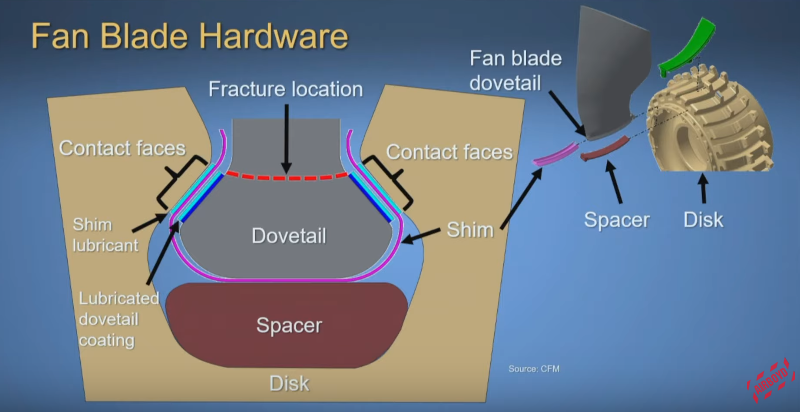
The impact of the separated fan blade with the fan case also imparted significant loads into the fan cowl that caused cracks to form in the fan cowl skin and frames near the radial restraint fitting. Subsequently, these damages then propagated forward and aft, severing the three latch assemblies that joined the inboard and outboard halves of the fan cowl, which caused large portions of both fan cowl halves to separate and depart the aircraft.
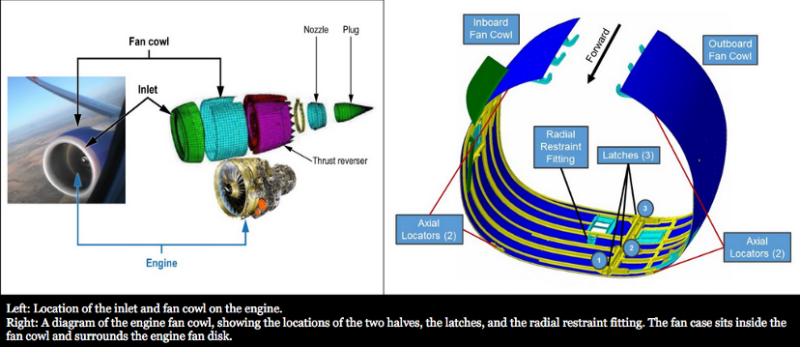
The impact of the inboard fan cowl aft latch keeper with the fuselage near the cabin window adjacent to seat 14A caused the window to depart the aircraft and the passenger fatality.
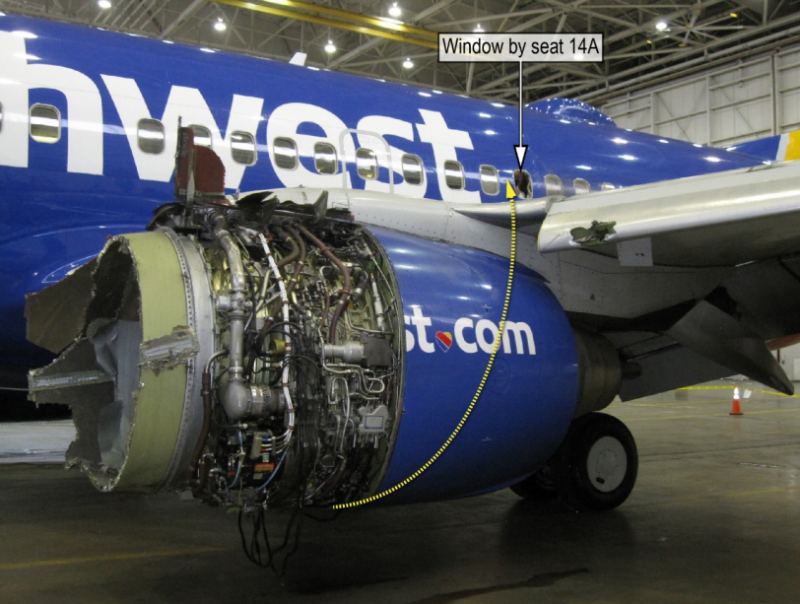
Probable Cause and Aftermaths
The NTSB determined that the probable cause of this accident was a low-cycle fatigue crack in the dovetail of fan blade No. 13, which resulted in the fan blade separating in-flight and impacting the engine fan case at a location that was critical to the structural integrity and performance of the fan cowl structure. This impact led to the in-flight separation of fan cowl components, including the inboard fan cowl aft latch keeper, which struck the fuselage near a cabin window and caused the window to depart from the aircraft, the cabin to rapidly depressurize, and the passenger fatality.
Following the accident, the NTSB issued five safety recommendations to the FAA, one to EASA and one to Southwest. The FAA ordered ultrasonic inspections of all high-cycle CFM-56 fan blades. Southwest also announced extra inspections of fan blades on all of its CFM-56 engines. As for the aircraft involved, it has not flown passengers since the accident and is grounded in Victorville, California to this day.
On the day of the incident, Elaine Chao, the United States Secretary of Transportation, made a statement commending, “the pilots who safely landed the aircraft and the crew and fellow passengers who provided support and care for the injured, preventing what could have been far worse.”
On May 1, 2018, U.S. President Donald Trump welcomed crew members and select passengers in a ceremony at the Oval Office of the White House, praising all for their heroism. Captain Shults also received an official commendation from Congress.
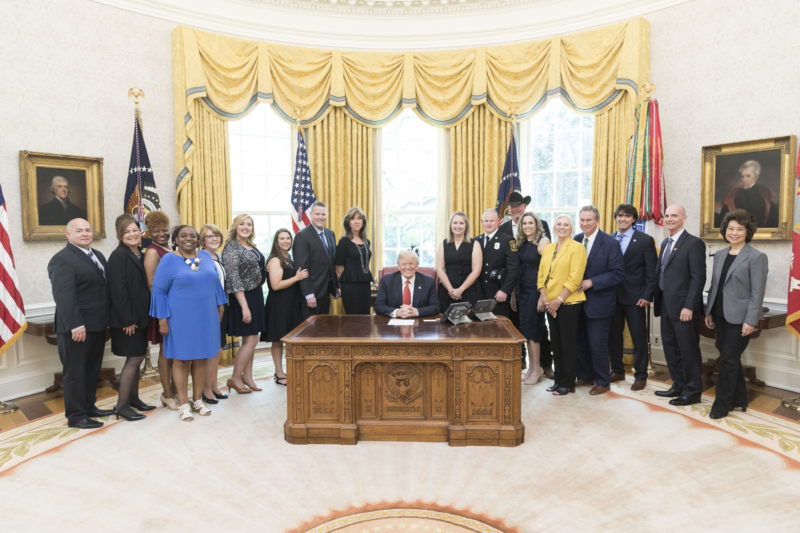
Instead of interviews, Captain Shults wanted to put her thoughts into a book and she wrote a book about the incident titled Nerves of Steel, which was published in the United States on October 8, 2019. Nerves of Steel gives a chilling account of how Shults and her F/O Darren Ellisor dealt with their own series of emergencies that could have sent the plane plunging into the fields of New Jersey or Pennsylvania. She has mentioned that the powerless engine and hole in the fuselage made the aircraft difficult to manoeuvre and they lost more than 18,000 feet of altitude in 18 minutes.

Source: NTSB, Wikipedia, CNN (Feature Image)


